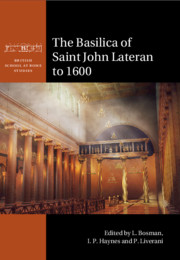Book contents
- The Basilica of Saint John Lateran to 1600
- British School at Rome Studies
- The Basilica of Saint John Lateran to 1600
- Copyright page
- Contents
- Figures
- Contributors
- Acknowledgements
- Abbreviations
- 1 The Lateran Basilica to 1600
- 2 The Evolution of the Lateran: From the Domus to the Episcopal Complex
- 3 At the Foot of the Lateran Hill, from Via Sannio to Viale Ipponio: Archaeological Investigations Prior to the Construction of Metro Line C
- 4 Ground-Penetrating Radar Survey in the Saint John Lateran Basilica Complex
- 5 The First Residential Phases of the Lateran Area and a Hypothesis to Explain the So-Called Trapezoidal Building
- 6 The Castra Nova and the Severan Transformation of Rome
- 7 Andrea Busiri Vici and the Excavations of 1876: A Reassessment of the Archaeological Evidence
- 8 Visualising the Constantinian Basilica
- 9 Constantine’s Spolia: A Set of Columns for San Giovanni in Laterano and the Arch of Constantine in Rome
- 10 The Constantinian Basilica in the Early Medieval Liber Pontificalis
- 11 The Lateran Baptistery in the Fourth and Fifth Centuries: New Certainties and Unresolved Questions
- 12 The Nymphaeum of Pope Hilarus
- 13 Examples of Medieval Construction Techniques in the Basilica of San Giovanni in Laterano
- 14 The Medieval Portico of Saint John Lateran
- 15 MATER ET CAPUT OMNIUM ECCLESIARUM: Visual Strategies in the Rivalry between San Giovanni in Laterano and San Pietro in Vaticano
- 16 The Remodelling of San Giovanni in Laterano by Pope Nicholas IV: Transept, Apse and Façade
- 17 Furtum Sacrilegum: The ‘Holy Heads’ of Peter and Paul and Their Reliquaries in the Lateran
- 18 Reconsidering the Traces of Gentile da Fabriano and Pisanello in the Lateran Basilica
- 19 The Rite of the Reconciliation of Penitents at the Lateran Basilica
- 20 The New Passion Relics at the Lateran, Fifteenth to Sixteenth Centuries: A Translocated Sacred Topography
- 21 The East Façade of the Complex of Saint John Lateran in the Modern Era
- 22 The Book of Acts in the Constantinian Basilica: Cardinal Cesare Baronio and the Navata Clementina in San Giovanni in Laterano
- Bibliography
- Index
20 - The New Passion Relics at the Lateran, Fifteenth to Sixteenth Centuries: A Translocated Sacred Topography
Published online by Cambridge University Press: 27 August 2020
- The Basilica of Saint John Lateran to 1600
- British School at Rome Studies
- The Basilica of Saint John Lateran to 1600
- Copyright page
- Contents
- Figures
- Contributors
- Acknowledgements
- Abbreviations
- 1 The Lateran Basilica to 1600
- 2 The Evolution of the Lateran: From the Domus to the Episcopal Complex
- 3 At the Foot of the Lateran Hill, from Via Sannio to Viale Ipponio: Archaeological Investigations Prior to the Construction of Metro Line C
- 4 Ground-Penetrating Radar Survey in the Saint John Lateran Basilica Complex
- 5 The First Residential Phases of the Lateran Area and a Hypothesis to Explain the So-Called Trapezoidal Building
- 6 The Castra Nova and the Severan Transformation of Rome
- 7 Andrea Busiri Vici and the Excavations of 1876: A Reassessment of the Archaeological Evidence
- 8 Visualising the Constantinian Basilica
- 9 Constantine’s Spolia: A Set of Columns for San Giovanni in Laterano and the Arch of Constantine in Rome
- 10 The Constantinian Basilica in the Early Medieval Liber Pontificalis
- 11 The Lateran Baptistery in the Fourth and Fifth Centuries: New Certainties and Unresolved Questions
- 12 The Nymphaeum of Pope Hilarus
- 13 Examples of Medieval Construction Techniques in the Basilica of San Giovanni in Laterano
- 14 The Medieval Portico of Saint John Lateran
- 15 MATER ET CAPUT OMNIUM ECCLESIARUM: Visual Strategies in the Rivalry between San Giovanni in Laterano and San Pietro in Vaticano
- 16 The Remodelling of San Giovanni in Laterano by Pope Nicholas IV: Transept, Apse and Façade
- 17 Furtum Sacrilegum: The ‘Holy Heads’ of Peter and Paul and Their Reliquaries in the Lateran
- 18 Reconsidering the Traces of Gentile da Fabriano and Pisanello in the Lateran Basilica
- 19 The Rite of the Reconciliation of Penitents at the Lateran Basilica
- 20 The New Passion Relics at the Lateran, Fifteenth to Sixteenth Centuries: A Translocated Sacred Topography
- 21 The East Façade of the Complex of Saint John Lateran in the Modern Era
- 22 The Book of Acts in the Constantinian Basilica: Cardinal Cesare Baronio and the Navata Clementina in San Giovanni in Laterano
- Bibliography
- Index
Summary
Compared to St. Peter’s, the privileged Roman pilgrimage destination since Early Christian times, the story of relic veneration at the Lateran is more ambiguous. There was no saint’s sepulchre as the devotional and liturgical focus of the church, and its principal relics had a strangely "abstract" character. Throughout the Middle Ages, different strategies were used to improve the reception of the Lateran relics, focusing principally on increased visibility. The peak of "making present" relics was reached with the fifteenth century, when a singular "reliquization" of several objects in the old Lateran palace took place, overlapping the abandoned patriarchíum with a new, sacred memorial topography (the palace of Pilate and other Holy Land sites). Many of these new relics were venerated in a particular performative and haptic way by the pilgrims who compared for example, their bodies’ height to the mensura Christi, passed the "doorways of the palace of Pilate" and progressed on their knees up the "Scala Santa", kissing the bloodstains which the Saviour had left on its steps. The chapter places the palace relics into the Lateran’s traditions and analyzes the reception strategies and veneration practices related to them, focusing especially on the role of materiality and physical approach as devotional means.
- Type
- Chapter
- Information
- The Basilica of Saint John Lateran to 1600 , pp. 428 - 465Publisher: Cambridge University PressPrint publication year: 2020
- 1
- Cited by

